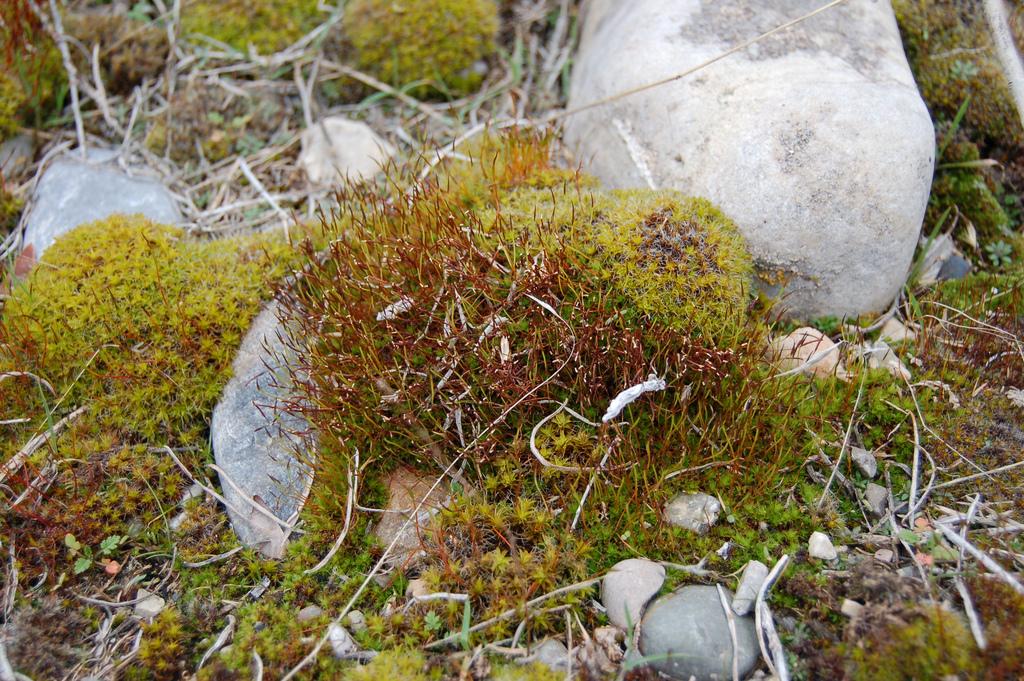Pottiaceae
|
Pottiaceae |
|
|
Plants usually turf-forming or loosely cespitose, green distally and brown proximally. Stems 0.2-4(-10) cm, irregularly branching, mostly rounded-pentagonal but occasionally rounded-triangular in section, hyalodermis usually absent, sclerodermis sometimes present, central strand usually present, radiculose, occasionally bare or tomentose, axillary hairs several cells in length, sometimes the proximal 1-3 cells brownish. Stem leaves usually appressed and often contorted when dry, spreading when wet, ovoid to lanceolate or lingulate, often channeled or keeled, rarely concave, mostly ca. 1.5-3.5 mm; base usually ovate to oblong, occasionally sheathing the stem; margins usually recurved proximally, occasionally plane, incurved, or involute, entire or sometimes dentate distally, occasionally bordered by thick-walled or elongate cells or cells in one or more layers; apex rounded-obtuse to more commonly narrowly acute; costa ending a few cells before the apex to short-excurrent or long-excurrent as an awn, sometimes with photosynthetic outgrowths adaxially, adaxial cells quadrate or elongate in usually 2-4 rows, costa in medial transverse section usually with a differentiated epidermis adaxially or on both sides, 1 or 2 stereid bands, the abaxial stereid band usually rounded or reniform, guide cells in 1(-3) layers, hydroid strand occasionally present (sometimes multiple); basal laminal cells usually differentiated, smooth or lightly papillose, rectangular, generally filling the base medially, sometimes rising marginally in a V shape, occasionally bulging, usually slightly wider than the distal laminal cells; distal laminal cells usually subquadrate, occasionally hexagonal or rarely short-rectangular or rhomboid, mostly small, ca. 9-16 mm wide, 1:1, papillae usually present over the distal laminal cells, solid or occasionally hollow, usually 2-fid but occasionally simple, sometimes flattened or compound, cell walls mostly evenly thickened, superficially flat to bulging, sometimes bulging only adaxially, usually in one layer. Specialized asexual reproduction common, by multicellular (rarely 1-cellular) gemmae borne on stalks in the leaf axils or more seldom on leaves, or by obovoid brood bodies borne on rhizoids in the soil, rarely by reduced or fragile leaves or fragile stems. Sexual condition dioicous or monoicous, occasionally rhizautoicous; perigonia and perichaetia terminal or occasionally lateral on short branchlets. Per This is the largest family of the mosses in number of genera. Its taxonomy is commonly considered difficult because of the obscure areolation, small size of the plants, and apparent phenotypic variation. A recent generic-level revision by R. H. Zander (1993) pulled together the scattered literature and de-emphasized sporophytic characters, allowing easier identification of sterile plants. The phylogenetic scheme adopted here approximates that of Zander (1993) as modified by Zander (2006) except that Gymnostomiella and Luisierella are moved from the Barbuloideae to the Pottioideae, in part for convenience in identification. The large number of anatomical characters available permits better identification of previously poorly understood taxa. The color tests refer to the reaction of the cell walls of the distal laminal areolation to 2% potassium hydroxide solution, which may require examination under the compound microscope for determination. Sectioning of leaf and stem is necessary and is described by Zander (1993). A twisted peristome, strongly differentiated costal anatomy, and the complexly papillose distal laminal cells are characteristic of this mostly acrocarpous family, commonly found in harsh environments.
|
|
